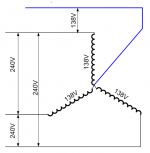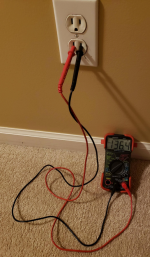Please keep in mind that this is something of a random musing thread, not something that I will ever implement.
The 'wagon wheel' does not use autotransformers; it uses a true isolating transformer arrangement. It is IMHO a 3 phase arrangement, but each phase has a full 120/240 center tapped secondary, allowing one to supply each apartment with 120/240 single phase rather than 120/208 pseudo single phase. This is no different than having 3 separate blocks each with their own single phase 120/240V transformer on a different distribution phase. The potential benefits are that the building presents a balanced 3 phase load to the utility, but with half the current on the 120V 'legs'. The customer sees a standard 120/240V. The downside is increased complexity, and possibly lower 'diversity' on each phase, since with a 120/208V system each phase is connected to more apartment feeders.
Here is the transformer diagram:
View attachment 2557526
The idea of a 'transition circuit' to 416/240V (where each residence just gets a single phase 240V L-N service) is to provide a hybrid system where each phase provides both 120 and 240V, but as L-N voltages, not standard split phase L-N-N 120/240V. Presumably the bulk of the loads (including receptacles) would be directly supplied with 240V (in the European fashion) but there would be a few 120V receptacles available.
The transformer diagram for this is:
View attachment 2557527
-Jon


